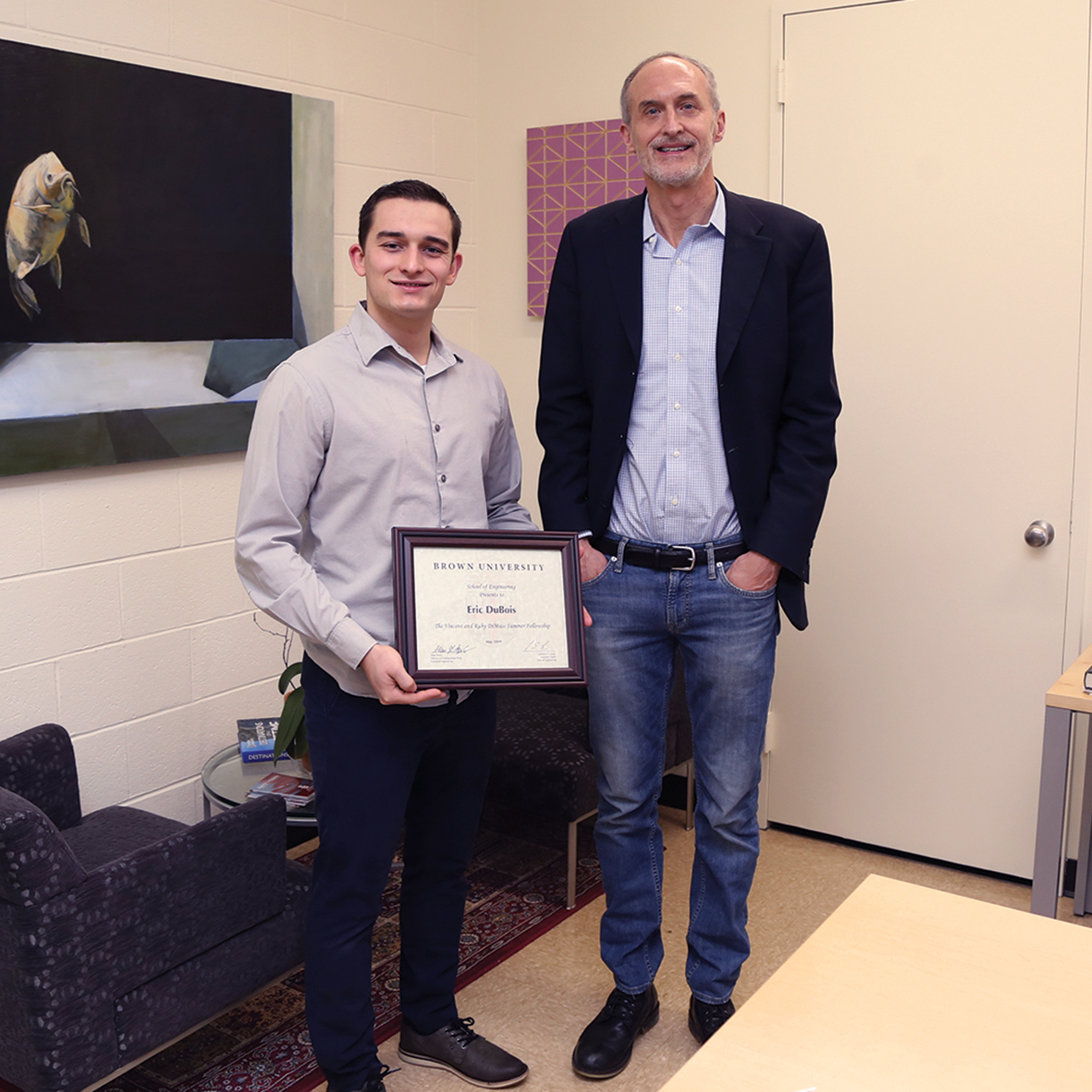Designing a future
DiMase Family Summer Internship recipient Eric DuBois ’20 is passionate about the intersection of design and research, and where the two may lead.
 Among the many places he can be found, Eric DuBois ’20 has logged countless hours in Assistant Professor Ian Wong’s lab for more than three years. Thanks to the generous award of the DiMase Summer Internship, he was able to further work where he was already credited as a second author on a publication in Polymer Chemistry (2019) and a fourth author on a publication in Carbon (2019). DuBois was part of a team in Wong’s lab that recently engineered new composite hydrogels that actuate in response to changes in external ion concentration, and demonstrated how these hydrogels can be interchangeably adhered together like Lego blocks for DIY microfluidic devices.
Among the many places he can be found, Eric DuBois ’20 has logged countless hours in Assistant Professor Ian Wong’s lab for more than three years. Thanks to the generous award of the DiMase Summer Internship, he was able to further work where he was already credited as a second author on a publication in Polymer Chemistry (2019) and a fourth author on a publication in Carbon (2019). DuBois was part of a team in Wong’s lab that recently engineered new composite hydrogels that actuate in response to changes in external ion concentration, and demonstrated how these hydrogels can be interchangeably adhered together like Lego blocks for DIY microfluidic devices.
“3D printed, plug-and-play systems could be the future of microfluidics. They allow for rapid prototyping of novel designs and are relatively low cost, making them accessible,” he said.
Complementing work begun by Thomas Valentin Ph.D. ’18, DuBois spent the summer designing microfluidic architectures and integrating biocompatible adhesives for the study of cell-cell interactions.
Continuing in Wong’s lab, he has now moved beyond the summer’s work with 3D microfluidics to a completely different scope of 2D nanofluidics, working alongside current Ph.D. candidate Catherine Machnicki. These researchers have been working with graphene oxide and the ion transport of fuel cells. “It’s completely different,” DuBois said. “Working with biomaterials is much more intuitive. The fabrication and characterization of devices containing 2D materials is much more precise and less forgiving. From a device design perspective, it’s an interesting challenge to build and design a device with material that you cannot see with the naked eye.”
DuBois also spent the fall semester as a teaching assistant for Assistant Professor David Borton’s Instrumentation Design (ENGN 1230) class. “It’s such an interesting course,” he said. “Working hands on with the devices that make up instruments, creating and troubleshooting simple circuits, and understanding the fundamental science behind these devices, is such a valuable experience.” This is just one of several experiences along the way that have made perfect sense for someone with a strong interest in design.
I was very interested in the Brown Design Workshop (BDW), but came from a non-technical background. I’m a perfect example of what you can accomplish in the space. In two years’ time, I went from being a user, to a monitor, to a manager.
“I think my time here has kind of been the same as many – you enter with a clean slate, and get the opportunity to rebuild yourself, right? I was very interested in the Brown Design Workshop (BDW), but came from a non-technical background. I’m a perfect example of what you can accomplish in the space. In two years’ time, I went from being a user, to a monitor, to a manager. The space’s primary goal is to provide intuition and learn how to use tools and techniques, while building up a community in a teaching atmosphere where no one has to feel uncomfortable to ask for help.”
Overlapping that with the launch of Design@Brown this fall, you can see why DuBois seems to be everywhere these days. The mission of Brown’s newest student group, D@B, is to bring design into an academic setting through classes, while offering mentorship to students and opportunities to develop ideas in the makerspace with a connector networking system.
“We want to expose everyone to design by people who may or may not be engineers by trade, and offer different perspectives. It’s a unification effort of things that were formerly manifested mostly in extra curriculars.”
It’s an effort the Moultonborough, N.H. native is proud to facilitate. He has been wearing multiple hats since arriving on College Hill, including as part of the Brown Entrepreneurship Program, and an e-board member of the Biomedical Engineering Society. DuBois feels being a biomedical engineering concentrator has afforded him the opportunity to become a jack-of-all-trades. He has had the ability to take advantage of opportunities and experiences that have come along, but also to play the role of project manager many times – watching as all components come together at the end of the day.
As he turns his attention toward graduate school, DuBois is thankful for the education Brown has given him. “I can knowledgeably read scientific papers about anything from tissue engineering to nanomaterials, really nothing is off-limits,” he said. He feels this, and working in the lab alongside graduate students, is what prepared and inspired his academic independence very quickly, and not in ways he necessarily expected.